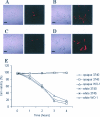In vivo and in vitro anaerobic mating in Candida albicans
- PMID: 17259544
- PMCID: PMC1828919
- DOI: 10.1128/EC.00316-06
In vivo and in vitro anaerobic mating in Candida albicans
Abstract
Candida albicans cells of opposite mating types are thought to conjugate during infection in mammalian hosts, but paradoxically, the mating-competent opaque state is not stable at mammalian body temperatures. We found that anaerobic conditions stabilize the opaque state at 37 degrees C, block production of farnesol, and permit in vitro mating at 37 degrees C at efficiencies of up to 84%. Aerobically, farnesol prevents mating because it kills the opaque cells necessary for mating, and as a corollary, farnesol production is turned off in opaque cells. These in vitro observations suggest that naturally anaerobic sites, such as the efficiently colonized gastrointestinal (GI) tract, could serve as niches for C. albicans mating. In a direct test of mating in the mouse GI tract, prototrophic cells were obtained from auxotrophic parent cells, confirming that mating will occur in this organ. These cells were true mating products because they were tetraploid, mononuclear, and prototrophic, and they contained the heterologous hisG marker from one of the parental strains.
Figures






References
-
- Bennett, R. J., and A. D. Johnson. 2005. Mating in Candida albicans and the search for a sexual cycle. Annu. Rev. Microbiol. 59:233-255. - PubMed
-
- Bennett, R. J., M. G. Miller, P. R. Chua, M. E. Maxon, and A. D. Johnson. 2005. Nuclear fusion occurs during mating in Candida albicans and is dependent on the KAR3 gene. Mol. Microbiol. 55:1046-1059. - PubMed
-
- Calderone, R. A. 2002. Candida and candidiasis. ASM Press, Washington, DC.
Publication types
MeSH terms
Substances
LinkOut - more resources
Full Text Sources
Other Literature Sources

